Tuning a Subaru
Tuning a Subaru
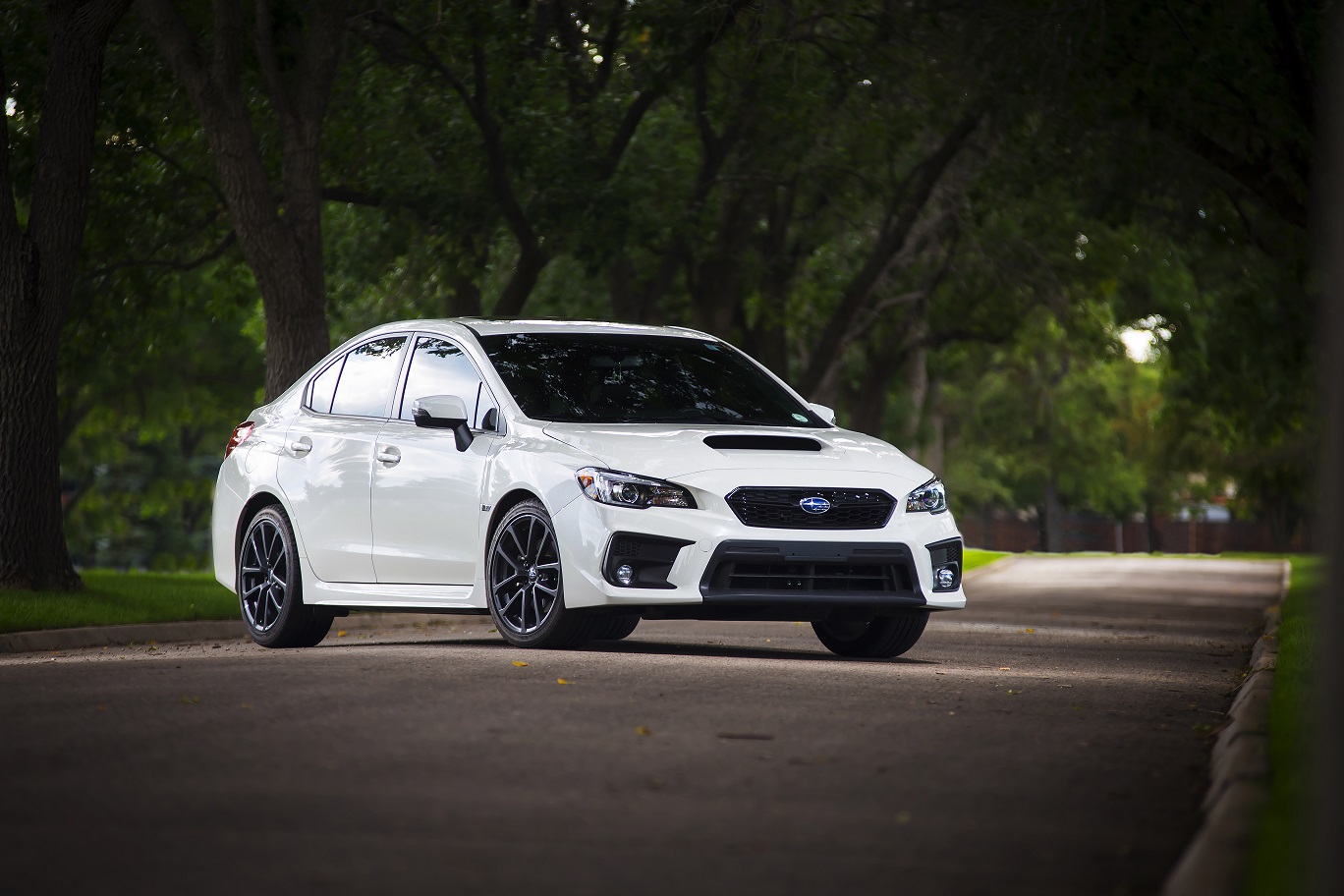
Most owners know by now that tuning a Subaru is one of the best bang for your buck modifications you can make. But, lesser known is how exactly to tune a Subaru. There are many ways accomplish tuning your Subaru. These can be incredibly complicated and involve knowing how to tune a car. Whether you’re tuning a BMW, tuning a Mustang EcoBoost, tuning a Volkswagen, or tuning a Subaru, the easiest and best method uses the COBB Accessport which requires no tuning knowledge whatsoever. The Accessport supports most turbo Subarus. The tuning process will be very similar to what is shown below. Power gains outlined below are specific to the 2015+ WRX 6MT. Visit the Subaru Map Notes pages for more details on power gains for other models.
How easy is it to tune a Subaru?
Tuning with the Accessport
Once you’ve received your Accessport, it’s time to use it to tune your Subaru! Let’s go through the process step by step to see just how easy tuning can be.
1. You will need the Accessport and OBD-II cable (included with the Accessport) to perform the installation. Make sure the vehicle’s ignition is off and the engine is not running.
2. Locate the Subaru’s OBD-II port. Location of the OBD-II port may vary depending on the vehicle model.
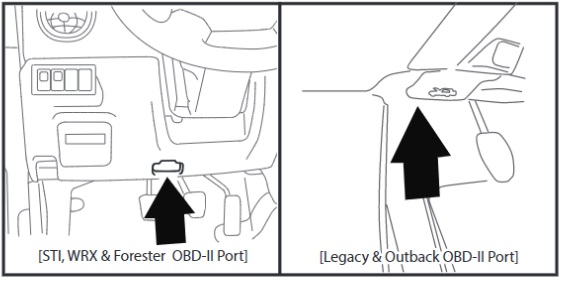
2.1. Plug the OBD-II cable into the OBD-II port under the dash of the vehicle.
3. Connect the small end of the OBD-II cable to the port on the bottom of the Accessport
4. Make sure the clasp on the OBD-II cable firmly engages with the Accessport.
5. We’ll need to get the Subaru in the “ON” position. To accomplish this, turn the key to the “ON” position. If you do not have a keyed ignition, simply press the Start button without your foot on the brake. Turn off all in-car electronics (AC/heater fans, headlights, stereo, etc.) and make sure all doors are shut.
6. Select Install from the Accessport menu by pressing the OK button to proceed with installation.
The Accessport will attempt to automatically determine the target vehicle for installation. Verify that the identified vehicle is correct and press OK to confirm. You will then proceed to selecting the “map” or tune you wish to install.
What Is A Map?
The Accessport reprograms the factory tuning parameters inside the engine control unit (ECU) using map files, which contain specially written instructions for the Accessport to follow during the reprogramming process. A map file can contain information for any number of different modifications or enhancements to a vehicle, ranging from a race map to an economy map for vehicles in different configurations. Through the use of the Accessport and different map files the ECU can be reprogrammed to accommodate virtually any vehicle configuration.
Map Selection
After the Accessport identifies the vehicle, it will present a list of maps. Maps that are not intended for the identified vehicle are displayed in gray. The Accessport will reprogram the ECU with the calibration data from the map selected for installation. This will become the base data for the ECU. To ensure the best performance, select the map that most closely matches the modification level of the vehicle.
If you are unsure about which map applies to your modification level, please see the Subaru Map notes for the for the modification requirements for each map.
Select a map and press OK to proceed with the installation. If you wish to see a longer description for the highlighted map, press and hold the OK button on the desired map.
The Accessport will automatically proceed with installation to the vehicle. At this point the Accessport reprograms the vehicle’s ECU with new program data and calibration parameters from the installation map file.
Follow all on-screen prompts on the Accessport to complete the installation process. The Accessport is now fully installed and ready for use on your Subaru and it is programmed with new calibration data. The Accessport does not need to be plugged into the vehicle for the calibration to be in effect. You can disconnect the Accessport at this time or leave it plugged in to use any of the many features outlined below.
Modification Requirements and Power Gains 2015+ WRX 6MT
 |
Stage1
|
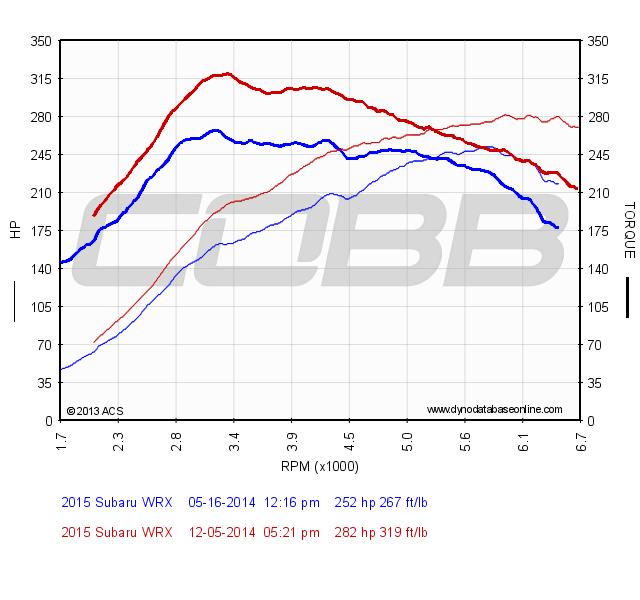 |
Stage2
|
Accessport Features for Subaru
Realtime Tuning: Changes can be made to the map in realtime, while the engine is running. Greatly speeds up the tuning process and allows quick changes to powerful features like Launch Control, Flat Foot Shift, and map switching.
Launch Control: Set RPM threshold for performance launching the car from a stop. Builds boost and generates instantaneous horsepower off the line.
Flat Foot Shifting: Keep the throttle on the floor during shifts and maintain boost between gears with this customizable RPM setting.
I Tuned my Subaru, Now What?
The Accessport for the Subaru is a powerful tool. Aside from being able to flash the ECU with different tunes, and a diagnostic tool able to read and clear codes, it can also display and record hundreds of different parameters. From Ambient Air Temperature to Vehicle Speed Sensors and everything in between, the Accessport will be able to provide you with the data you need.
Data Monitoring
The Gauges menu contains all monitoring and datalogging settings. The first time a V3 Accessport enters the Gauges menu, you’ll be asked how many monitors you would like to display.
Each time you return to the Gauges menu, the selected layout/number of gauges will be used until it is changed in the Gauges Setup menu. This provides the ability to monitor different things in different situations. You can select 1 or 2 gauges to be prominently displayed for the track and have different settings with more gauges for street/economy monitoring.
Every Subaru Accessport will come with a default monitor log list. This is a good starting point to get an overview of what the car is doing. If you wanted to determine something more specific, you can change the monitors that are being datalogged. This can be done by
Entering the Gauges menu

Then, enter the datalogging/gauges setup menu by selecting the arrow at the top of the gauges screen, then enter the Configure Datalogging menu.
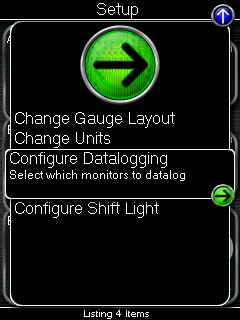
Once in the Configure Datalogging menu select the monitors you would like to log.
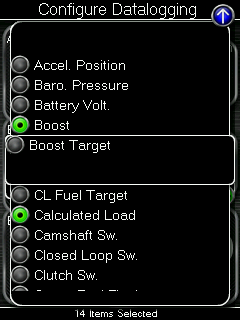
Then, press the Back (left) button to save the changes. You’re ready to take a log!
Datalogging
It’s important that certain conditions are present when trying to determine if the car is healthy and performing as it should. Typically, you won’t get much relevant diagnostic data through idling or light throttle conditions. We recommend a 3rd gear Wide Open Throttle pull from about 2500 RPM to near redline. Any potential issues will usually be evident during this event.
To begin the log enter the Gauges menu

Then, press the OK (center) button to start datalogging. Once started, a scrolling dot will appear on the screen along with the logging rate displayed at the bottom.

Press the OK button or Cancel button to stop datalogging. You can then connect the Accessport to Accessport Manager on your computer and download the catalog files in the Manage tab. Up to ten (10) datalogs can be stored on the Accessport at any time. The lowest number is the oldest log and the highest number is the newest.

You can then open the datalog in any spreadsheet or log viewer application. For most applications, double-clicking on the datalog will open the file properly.
What do all of these parameters mean? You can find a brief description for each on our Subaru Monitor List.
Important Monitors
A/F Learning 1
This monitor shows a percentage correction for fueling. Positive numbers indicate that fuel is being added. Negative numbers indicate that fuel is being removed. The closer to zero the better, but generally, the acceptable range would be +/- 8%.
Negative corrections beyond 8% mean the ECU is pulling lots of fuel. This would most likely be due to a leak in the intake tract. Other potential issues could be a bad MAF sensor, failing o2 sensor, or you may have a map flashed that is not designed for your intake or injectors.
Positive corrections beyond 8% mean the ECU is adding lots of fuel. There are several potential culprits in this situation. A failing fuel pump, dirty fuel injectors, or bad MAF or o2 sensors would all be good starting points to address the problem. As always, having parts installed not designed to work with the map you are running could also cause high positive fuel trims.
MAF and o2 sensors are typically on their way out after ~100k miles. If yours are still original, and you have mileage beyond 100k, replacing these sensors would be recommended. Definitely replace the front o2 if engine or turbo damage has ever occurred. When it comes to these critical sensors, always use OEM parts from a Subaru dealer or a re-seller of genuine Subaru OEM parts.
Boost
Boost is the manifold absolute pressure minus the current barometric pressure measured in PSI (or bar if you prefer to configure the units in metric). Positive numbers indicate the intake manifold’s boost pressure and negative numbers indicate the car is in vacuum. You should consult the map notes to determine the target boost value for your specific map. STIs have different boost targets within the same map depending on the drive mode selected. Note that this target range will only be achieved during wide open throttle through mid-range RPM with load on the engine. It is normal for boost to taper down as you approach redline.
We typically recommend a third gear pull to gather this data. You can then compare the boost values in your data log to the target in the map notes to determine whether you are under/overboosting. Many vehicles have off the shelf high wastegate and low wastegate maps that address vehicles under/overboosting. Higher altitudes and any mechanical issues should be considered when concluding whether you are under/overboosting. More details on these maps and these issues can be found here.
The monitor can also help determine whether a vacuum leak exists. Actual vacuum at idle will vary from car to car (it is typically around -10 for these Subarus) but if you’re only seeing -2 at idle, it’s safe to say you likely have a vacuum leak somewhere. This will negatively impact how the car runs and could prevent you from reaching target boost.
DAM
The DAM, or Dynamic Advance Multiplier, adjusts the vehicle’s overall timing based on its current and historic knock readings. This parameter is useful in determining the overall health of the vehicle.
For the 02-05 WRX this value will range from 0-16 and for other EJ model Subarus it will range from 0-1. The starting point after a flash will vary depending on the model and tune but you always want the DAM to “learn” up to its maximum value.
This value will reset after an map reflash, an ECU reset, or a battery disconnect. But, if you see it drop under any other circumstance, you could have a potential knock issue. The following parameters can help determine if that is the case.
Fine Knock Learning
Fine Knock learning, sometimes abbreviated FKL, is a learned correction that the ECU uses to make tweaks to timing. If FKL hits extreme values, the ECU will consider modifying the DAM. Corrections start as a multiple of -1.4, and are learned away in increments of .35. With that in mind, if you see a -1.05 correction, knock is not currently occurring and timing is already being added back in.
Feedback Knock Correction
Feedback Knock Correction is an instant response the ECU applies to timing based on a knock event occurring. An initial value is typically -1.4 or -2 depending on the ECU. You may see this on occasion especially at low loads. This is common and will happen on a completely stock vehicle. If you see these Feedback Knock corrections of -4 or higher at wide open throttle, that is cause for concern needs investigation. More details for interpreting knock on the Subaru platform can be found here.
Additional Monitors
There are several other monitors that can be utilized depending on your personal preference. Seeing certain variables before and after modifications is a great indicator of whether they are providing real results. For instance, being able to monitor both Ambient Air Temperature and Charge Air Temperature and comparing them in real time is revealing. You can see just how much more efficient that new FMIC is! Monitoring/Logging Airflow Mass can also be indicative of whether that new Intake is doing work! Another great comparison is to see what the car is doing between the Stage 0 (stock map installed mode) and our Stage 1 map. This way, you can be 100% certain nothing detrimental is happening with the upgraded tune.
Our customer service is among the best in the industry. If you need help taking or interpreting your datalog or trying to diagnose an issue, send it to us at support@cobbtuning.com and we’re always happy to take a look and point you in the right direction.

Great information! Just picked up my AP last week and had a few questions. After purchasing my 09 wrx from a local dealership a few months back, I noticed that the car had a few modifications ie catless downpipe, aftermarket exhaust, and air intake. The car had a cable im assuming from an older ap but not sure if the car was tuned previously; I was wondering if it is a bad idea to load a map from the v3 over any possible preexisting (maps/tunes) or if you recommend a pro tune first; Really not trying to damage this car in anyway and love the new AP! Thanks!
Hi Spencer,
If the car runs well now, I would recommend leaving it as. There are no off the shelf maps compatible with a catless downpipe. The only intake support is the COBB SF intake. Loading any off the shelf map with a catless downpipe or a different intake will cause issues.
Kyle@COBB
Hey guys I had a question regarding a 2015 tune. I own a 2017 wrx and my buddy and i have the same list of mods so he shared his tune with me via email. however he has a 2015 wrx. Will i be able to flash this onto my 17 wrx or do they have a different ecu. Ive tried to google my question, but nothing turned up.
Hey Jonathan, you will not be able to use your friend’s map on your car. The 2015 and 2017 WRXs do share ECU hardware, but the software and tuning data is slightly different. Beyond that, if your friend’s map was created by one of our Protuners or in our Accesstuner software, it will be locked to his Accessport serial number and cannot be used with another Accessport.
Marshall@COBB
It’s interesting to know that there are pieces of software that are used for Subaru tuning. I want to know more about that because I sometimes take my husband’s car to a shop for maintenance. Knowing more about how its engine is tuned will be a huge help.
I appreciate that you explained the importance of a proper exhaust system for the best tuning approach. Last night, my cousin told me that he plans to consult a custom performance tuner for his Subaru Impreza, which has new intake and exhaust valves. He asked if I had any suggestions for what he should do. Thanks to your helpful tuning guide article for a safe approach. I’ll be sure to advise him that he should contact a well-known custom Subaru tuning service for further information about the modifications.